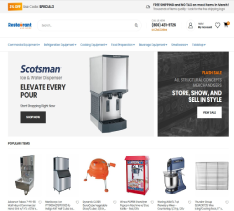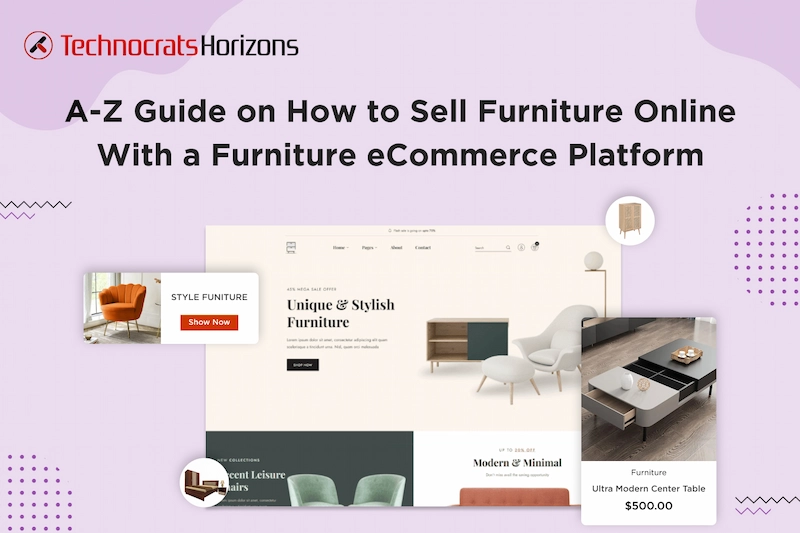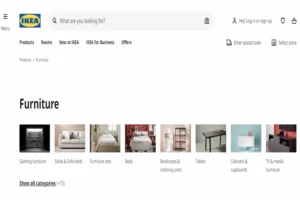Do you ever feel like your business is not generating your target revenue without knowing where it is going wrong? Well, if you’re a furniture business not yet in the eCommerce game, that might be the case.
82% of customers are already scrolling, clicking, and shopping online for their next furniture piece. So stop waiting and start your eCommerce journey now!
We understand that taking such a complicated, extensive, and customized business online can seem like a daunting task. That’s why you need a dedicated furniture eCommerce platform.
Confused about what exactly is it? This guide is custom-made for those furniture business owners who are looking to explore the great potential and benefits of selling furniture online.
Let’s explore the reasons behind this change, the must-have features of a robust furniture eCommerce platform, and the step-by-step process to transition your business into a digital success seamlessly.
The Changing Dynamics of the Furniture Industry
With the global eCommerce market projected to hit $70.9 trillion by 2028, you can understand the level of convenience eCommerce possesses.
As times have changed, people have built a comfort with online shopping, simply because it is much more convenient than offline shopping. Customers are most comfortable in their own homes and seek the benefits of exploring and purchasing furniture from there only. You need to adapt your business to this shift to stay relevant and accessible.
Digital Transformation in Furniture
The furniture industry has come a long way from just being a brick-and-mortar business. Virtual and augmented reality have revolutionized the landscape of furniture shopping. You can provide your customers with immersive shopping experiences that make customers feel good about their shopping choices.
Studies show that 63% of consumers are more likely to make an online furniture purchase if it offers an AR experience.
Integrating such technologies for selling furniture online may seem futuristic, but it’s a move that attracts tech-savvy customers toward your furniture eCommerce platform.
Necessity of an Online Presence
According to Accenture, 80% of shoppers begin their product searches online.
If you don’t have an online furniture shopping website in the modern era, then you are cutting down your potential revenue. The reason is very simple, people are buying from those who have a furniture eCommerce website so you need to have your own online furniture shopping website right now. Without an online presence, your furniture business risks losing potential customers at the initial stages of their buying journey.
Reasons to Embrace an Online Furniture eCommerce Platform
There’s no doubt that the current market conditions are embracing furniture eCommerce solutions with open arms and the reasons are all here for you to discover:
1. Breaking Geographical Barriers
Do not limit yourself to a small selling area. A furniture store eCommerce platform allows your business to overcome geographical limitations and reach international customers. By catering to a global audience, you have the opportunity to sell to a larger customer base.
Just ensure you’re investing in a powerful online furniture selling platform that gives you the flexibility to expand your capacity for an extensive portfolio and customer base. For example, the Scandinavian furniture brand IKEA expanded its reach globally through its well-established online presence.
2. Catering to the Modern Consumer
Modern consumers lack time and flexibility for old-school shopping. They need an online furniture shopping website where they can buy 24/7 from anywhere. With the ability to shop 24/7, online furniture eCommerce platforms cater to customers living in different time zones and schedules. The secret to Amazon’s success is its commitment to be accessible to its customers 24/7.
Ready to Revolutionize Your Furniture Business? Embrace eCommerce Now!
3. Enhancing Customer Experience
Customer satisfaction is at the center of any online business. Your furniture store eCommerce platform needs to have an easy-to-navigate and very intuitive user interface so your customers can shop your furniture pieces with ease. The best example of this is a renowned furniture eCommerce brand Crate & Barrel who possess a very user-friendly interface that has customers praising them.
4. Streamlining Operations
Beyond the advantages of global reach, online platforms streamline various business operations. The need for extensive physical infrastructure and personnel is reduced, contributing to cost efficiency. Wayfair’s efficient supply chain and fulfillment centers showcase the cost-saving benefits of an optimized online model.
5. Minimizing Physical Infrastructure Costs
Maintaining physical stores entails significant costs. Running an offline store means hiring a bigger staff, renting out multiple showrooms, stationary expenses, and much more. But you can avoid all of these expenses by investing in an online furniture selling platform.
The biggest example is the success of online-first brands like Burrow. They started as a direct-to-consumer online furniture retailer and their digital-first approach showed the world how significant amounts of costs can be saved by investing in a great furniture eCommerce solution.
Key Features of a Successful Furniture Store eCommerce Platform
We have compiled a few features that will make the online shopping journey enjoyable for both you and your customers. Go ahead and see how each of them can transform your business:
– Intuitive Navigation
An intuitive interface simplifies the customer journey, ensuring a positive and enjoyable shopping experience. You need to review your furniture eCommerce website and see if it is offering a seamless shopping experience or not. Optimize your online furniture selling website to make it easy for customers to explore and find products.
– Mobile Responsiveness
We live in a world where people use multiple devices to shop for everything. A mobile-responsive design ensures your furniture business is accessible across smartphones, tablets, and computers. It’s almost like having an online store that follows your customers wherever they go.
The mobile-responsive design of IKEA’s website allows them to reach customers on various devices which enhances their shopping experience multifold. This feature can make your business stand out if you take IKEA’s mobile responsive design as an example.
– High-quality Visuals and 3D Product Display
What grabs a customer’s attention at first sight? You’re right, it’s how your products look. High-quality visuals create a positive impression on the customer’s mind. So invest in professional photography to make your furniture look high-end. You can also highlight the key features through visuals to showcase the uniqueness of your furniture pieces via 3D visualization. To have all this, look for high-quality furniture eCommerce software.
Build a High-Performing Furniture eCommerce Store with These Must-Have Features!
– Automated Alerts and Notifications
Having a furniture eCommerce website with a great inventory management system can elevate your business multifold. If you’re running a furniture eCommerce business, then automated alerts for low stock levels can help you maintain optimal inventory levels.
Especially it’s a necessary feature to have in a furniture eCommerce platform for manufacturers since they need to always keep an eye on the stock level.
– Virtual Try-Before-You-Buy Experience
Have you thought about what’s stopping customers from buying your furniture online? Because they feel uncertain about how that product will look in their home or office. If you invest in an online furniture shopping website that offers a virtual try-before-you-buy experience then it can boost the customer confidence in making online purchases.
Look for furniture eCommerce solutions with integrated AR/VR. See if your customers virtually place your furniture in their homes before buying. This interactive feature elevates your customer engagement to the next level and it is a good tactic for customer retention.
– AI-driven Recommendations
Who does not like getting product recommendations they care about? With artificial intelligence, you can provide your customers with personalized product recommendations. Explore furniture eCommerce software where you can leverage customer data to offer personalized suggestions.
Take inspiration from Amazon’s recommendation engine, powered by AI algorithms, which is a prime example of how tailored suggestions can drive high customer engagement.
– Multibrand Management
Many furniture businesses deal with multiple brands. Having a furniture eCommerce platform for retailers gives you the flexibility to add those multiple brands on a single furniture eCommerce software. Multibrand management allows you to provide your customers with a diverse and well-curated selection of furniture that is otherwise difficult to access from a single place.
– Modular Product Configuration
All customers often have different preferences when it comes to furniture depending on their space, color schemes, or styles. Modular product configuration allows them to personalize their choices, creating furniture that suits their unique taste and needs.
Having this choice encourages customers to make that final buying choice so your online furniture eCommerce furniture platform must have the functionalities to provide these options and a 3D visualization feature paired with this feature is definitely a plus.
– Streamlined Experience for Wholesale Buyers
Many furniture eCommerce websites offer a selling option to retailers but there’s also a market for furniture eCommerce platforms for wholesalers. Wholesalers often place bulk orders with specific requirements. This type of furniture eCommerce platform simplifies the purchasing process for wholesalers which saves them time and ensures a hassle-free experience.
– Custom Pricing Mechanism
Not all products are created equal, and neither should their prices. A custom pricing mechanism accommodates varied pricing models for different products, ensuring accuracy and fairness. Specifically for businesses offering highly customized furniture items, this feature makes it easier and faster for you to provide accurate pricing.
The Step-by-Step Process of Implementing an Online Furniture Selling Platform
Now that we have explored the essential features of an ideal online furniture eCommerce software, it’s time to discuss how to explore how exactly you can implement it. Here is the step-by-step process crafted exclusively for you:
A. Market Research and Competitor Analysis
Thorough market research helps in identifying your target audience, and ensuring your products align with customer preferences. Invest time in understanding your audience. What are their preferences and pain points? This helps you in customizing your online furniture selling platform for their needs.
Studying competitors provides insights into successful strategies, helping you refine your approach. Look into your competitors. What strategies are working for them? Can you adapt or enhance similar strategies for your business? Answering these questions with proper research can give direction to your business.
B. Choosing the Right eCommerce Platform
Selecting a platform with customization options is vital for reflecting your brand identity. Consider your brand aesthetics. Can you customize your online presence to align with your brand identity? Look for online furniture shopping platforms offering flexibility in design.
Choosing a scalable furniture eCommerce software sets the foundation for future growth. Evaluate your growth plans. Analyze if your chosen platform is capable of scaling your business. Invest in a furniture eCommerce that accommodates future expansion.
Launch Your Own Online Furniture Store Today with Our Expert Guide!
C. Building a Compelling Online Store
Investing in professional design and branding contributes to a visually appealing online store. Review your online store. Does it reflect your brand’s visual identity? Invest in an online furniture shopping website with design elements that enhance the overall aesthetics of your brand.
The branding of Joybird, known for its mid-century modern furniture, exemplifies how design consistency enhances brand identity.
Furthermore, compelling product descriptions and SEO improve visibility, attracting more potential customers. Enhance your online content and ensure your product descriptions are detailed and engaging.
D. Integrating eCommerce Features
Integrating reliable and secure payment gateways is fundamental for seamless transactions. Evaluate your payment options. Can customers choose from diverse payment methods? Ensure your system supports various payment gateways for customer convenience.
Implementing an efficient inventory management system that syncs with your online store is crucial. Optimize your inventory processes so that you can provide real-time stock information to customers. Ensure your inventory system is seamlessly integrated into your furniture eCommerce solution.
E. Marketing and Promotions
Utilizing social media platforms for promotion and engagement is essential. Dive into social media. Is your online furniture eCommerce platform visually appealing? Craft engaging content that resonates with your audience.
Implementing email marketing campaigns and loyalty programs keeps customers engaged. Explore customer loyalty initiatives. Can you create personalized loyalty programs? Implement email campaigns that foster customer retention.
F. Monitoring and Continuous Improvement
Regularly monitoring analytics and tracking the performance of your online store is critical. Dive into analytics. What metrics are you tracking, and how can they inform your decisions? Implement data-driven improvements for continuous enhancement.
Encouraging customer feedback and using it to adapt and refine your online platform is a continuous process. Seek customer input actively. What are their suggestions for improvement? Embrace a responsive approach, adapting your platform based on customer feedback.
How to Sell Furniture Online Through Furniture eCommerce Store
A good marketing approach should be followed by an excellent sales strategy. Since the end goal of every furniture eCommerce platform is to do online sales, the below-given tips will help you to build a sales strategy that complements your online store:
1. Product Photography and Videography
According to a study by BigCommerce, 78% of online shoppers want more images from eCommerce sites.
Clear, well-lit images and engaging videos offer potential customers a virtual showroom experience, allowing them to appreciate the intricacies of your products.
Consider hiring a professional photographer or investing in quality equipment if possible. Provide multiple angles, close-ups, and lifestyle shots to give customers a comprehensive view.
2. Writing SEO-Rich Product Descriptions
Compelling product descriptions are your online sales pitch. Beyond listing specifications, tell a story about each piece. Highlight the unique features, the inspiration behind the design, and the materials used. Use language that resonates with your target audience, whether it’s the elegance of a vintage table or the modern aesthetic of a minimalist chair.
Optimize your descriptions for search engines by incorporating relevant keywords naturally. Think about the questions customers might have and address them in your product descriptions. The goal is not just to sell a product but to create a connection with the customer.
3. Offer Transparent Pricing and Discounts
According to stats, 54% of customers will buy the products if offered again at a discounted price.
Transparent pricing is crucial in the furniture eCommerce market. Display the prices of your furniture, and if applicable, offer various pricing tiers for customization options. Consider implementing discounts or promotions strategically to drive sales. Limited-time offers or bundling deals can create a sense of urgency, encouraging customers to make a purchase.
4. Upselling and Cross-Selling
According to a report, product recommendations account for up to 31% of eCommerce revenues.
Don’t just focus on finishing a sale but ensure that customers buy more than what they came for. For upselling, encourage customers to consider premium or upgraded versions of the furniture they’re interested in. For cross-selling, suggest complementary pieces that enhance their overall decor.
Use strategic placement on your website to showcase upsell and cross-sell options during the customer’s shopping journey.
Ready to Boost Sales with an Online Furniture Store? Reach Out Now!
Case Studies of Successful Furniture eCommerce Brands
Let’s delve into real-world examples of furniture businesses that have successfully transitioned to eCommerce, showcasing the transformative power of an online presence.
1. IKEA: A Global Furniture Giant
IKEA, known for its affordable and stylish furniture, has seamlessly embraced eCommerce to cater to a global audience. Their online platform allows customers to explore and purchase a vast range of furniture items, from dining tables to sofas, with the convenience of doorstep delivery
Key Takeaway: IKEA’s success demonstrates the global reach and accessibility that eCommerce offers to furniture businesses. Their user-friendly website and efficient logistics showcase the potential for scaling operations through online channels.
2. Wayfair: Online Furniture Marketplace
Wayfair has established itself as a prominent furniture eCommerce marketplace. It has become a go-to destination for those seeking unique and affordable furniture pieces by curating a diverse range of products and employing targeted digital marketing strategies.
Key Takeaway: Wayfair’s success highlights the importance of a well-executed online marketplace, where a wide variety of products meets the demands of a broad customer base. Their use of SEO, content marketing, and strategic partnerships have contributed to their prominence in the online furniture landscape.
3. Etsy: A Premium Customized Furniture eCommerce Platform
Etsy has become a hub for independent artisans and custom furniture makers to showcase their creations. With a focus on unique, handcrafted items, Etsy provides a platform for small businesses to thrive in the competitive world of online retail.
Key Takeaway: Etsy exemplifies how eCommerce can empower small furniture industry businesses. By emphasizing craftsmanship, customization, and a direct connection with customers, Etsy demonstrates the potential for niche markets within the online landscape.
Conclusion
After exploring the ins and outs of furniture store eCommerce platforms through this guide, we are sure that you must have made up your mind about investing in it. But this is such a technical and complex task that you will need professional help.
Technocrats Horizons, a leading eCommerce development and digital transformation company, offers end-to-end eCommerce solutions for the furniture industry. With our furniture eCommerce platform, you won’t have to worry about a single thing as it comes with a highly intuitive, interactive, and customized interface for building high customer engagement and simplifying the shopping process while our powerful backend takes care of your eCommerce business operations. Reach out to us for a quick discussion about your business and we will offer the best solutions for it.
Looking for a All-in-one Furniture eCommerce Platform? Reach Out Now!
Launch your online store with ease!
Book a demo to see how our solution helps you showcase, sell, and manage cabinets and furniture effortlessly.











 Request a
Request a





























